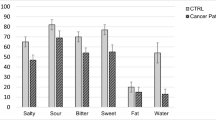Abstract
Goals of work
The aim of the study was to measure taste thresholds among cancer patients under chemotherapy compared to controls.
Patients and methods
The study was performed with 110 cancer patients and 170 healthy subjects of similar age distribution were included in the study. The electrogustometric detection threshold was evaluated as the lowest current intensity perceived by the subject in three tongue sites independently with a constant current generator.
Main results
Taste thresholds for all cancer patients demonstrated significantly higher values compared to controls.
Conclusions
Cancer patients treated by chemotherapy demonstrated a temporary taste sensitivity deficit. Associated with the illness due to the treatment, this deficit explains the patients complaining of “abnormal or bad tastes”, which results in food aversion and has a negative impact on nutritional status and quality of life. In order to prevent the risk of anorexia and the enhanced morbidity related to this deficit, treatment should include relevant information to the subject for anticipating objective taste modifications and a psychological follow-up during the actual change of taste quality perceptions in everyday life.



Similar content being viewed by others
References
Bartoshuk LM (1990) Chemosensory alterations and cancer therapies. NCI Monogr 9:179–184
Beidler LM, Smallman RL (1965) Renewal of cells within taste buds. J Cell Biol 27:263–272
Beidler LM, Smith JC (1991) Effects of radiation therapy and drugs on cell turnover and taste. In: Getchell TV et al (eds) Smell and taste in health and disease. Raven, New York, pp 753–763
Bernstein IL (1978) Learned taste aversions in children receiving chemotherapy Science 200:1302–1303
Bernstein IL, Treneer CM, Goehler LE, Murowchick E (1985) Tumor growth in rats: conditioned suppression of food intake and preference. Behav Neurosci 99:818–830
Buntzel J, Glatzel M, Kuttner K, Weinaug R, Frohlich D (2002) Amifostine in simultaneous radiochemotherapy of advanced head and neck cancer. Semin Radiat Oncol 12:4–13
Comeau TB, Epstein JB, Migas C (2001) Taste and smell dysfunction in patients receiving chemotherapy: a review of current knowledge. Support Care Cancer 9:575–580
Frank ME, Smith DV (1991) Electrogustometry: a simple way to test taste. In: Getchell TV et al (eds) Smell and taste in health and disease. Raven, New York, pp 503–514
Frank ME, Hettinger TP, Herness MS, Pfaffman C (1986) Evaluation of taste function by electrogustometry. In: Meiselman HL, Rivlin RS (eds) Clinical measurement of taste and smell. Macmillan, New York, pp 187–199
Ganchrow JR, Ganchrow D, Royer SM, Kinnamon JC (1993) Aspects of vertebrate gustatory phylogeny: morphology and turnover of chick taste bud cells. Microsc Res Tech 26:106–119
Herness MS (1985) Neurophysiological and biophysical evidence on the mechanism of electric taste. J Gen Physiol 86:59–87
Holmes S (1993) Food avoidance in patients undergoing cancer chemotherapy. Support Care Cancer 1:326–330
Le Floch JP, Le Lievre G, Verroust J, Philippon C, Peynegre R, Perlemutter L (1990) Factors related to the electric taste threshold in type 1 diabetic patients. Diabet Med 7:526–531
Mattes RD (1994) Prevention of food aversions in cancer patients during treatment. Nutr Cancer 21:13–24
Mattes RD, Arnold C, Boraas M (1987) Learned food aversions among cancer chemotherapy patients. Cancer 60:2576–2580
Mattes RD, Curran WJ, Alavi J, Powlis W, Whittington R (1992) Clinical implications of learned food aversions in patients with cancer treated with chemotherapy or radiation therapy. Cancer 70:192–200
Miller SL, Mirza N, Doty RL (2002) Electrogustometric thresholds: relationship to anterior tongue locus, area of stimulation, and number of fungiform papillae. Physiology & Behavior 75:753–757
Mojet J, Christ-Hazelhof E, Heidema J (2001) Taste perception with age: generic or specific losses in threshold sensitivity to the five basic tastes? Chem Senses 26:845–860
Ninomiya Y, Mizukoshi T, Nishikawa T, Funakoshi M (1987) Ion specificity of rat chorda tympani fibers to chemical and electrical tongue stimulations. Brain Res 404:350–354
Oakley B (1974) On the specification of taste neurons in the rat tongue. Brain Res 75: 85–96
Ovesen L, Sorensen M, Hannibal J, Allingstrup L (1991) Electrical taste detection thresholds and chemical smell detection thresholds in patients with cancer. Cancer 68:2260–2265
Rhodes VA, McDaniel RW, Hanson B, Markway E, Johnson M (1994) Sensory perception of patients on selected antineoplastic chemotherapy protocols. Cancer Nursing 17:45–51
Rozin P (1968) Specific aversion and neophobia resulting from vitamin deficiencies or poisoning in half wild and domestic rats. J Comp Physiol Psychol 66:82–88
Schiffman S (1983). Taste and smell in disease. N Engl J Med 308:1337–1342
Schiffman S (1991) Drugs influencing taste and smell perception. In: Getchell TV et al (eds) Smell and taste in health and disease. Raven, New York, pp 845–850
Shils ME (1977) Nutritional problems induced by cancer. Med Clin North Am 63:1009–1025
Tomita H, Ikeda M (2002) Clinical use of electrogustometry: strengths and limitations Acta Otolaryngol [Suppl] 546:27–38
Wickham RS, Rehwaldt M, Kefer C, Shott S, Abbas K, Glynn-Tucker E, Potter C, Blendowski C (1999) Taste changes experienced by patients receiving chemotherapy. Oncol Nurs Forum 26:697–706
Acknowledgments
The authors are indebted to Didier Trotier for reading the manuscript.
Author information
Authors and Affiliations
Corresponding author
Rights and permissions
About this article
Cite this article
Berteretche, M.V., Dalix, A.M., d’Ornano, A.M.C. et al. Decreased taste sensitivity in cancer patients under chemotherapy. Support Care Cancer 12, 571–576 (2004). https://doi.org/10.1007/s00520-004-0589-2
Received:
Accepted:
Published:
Issue Date:
DOI: https://doi.org/10.1007/s00520-004-0589-2




